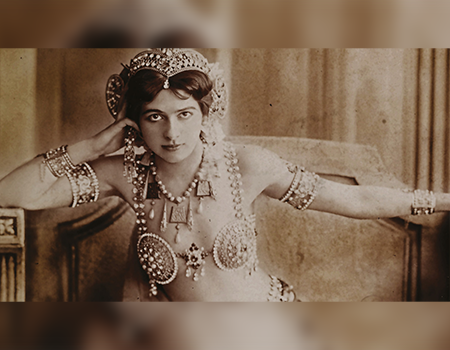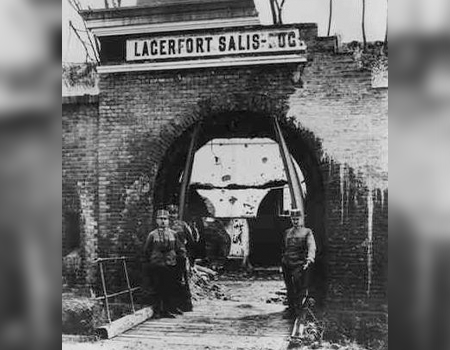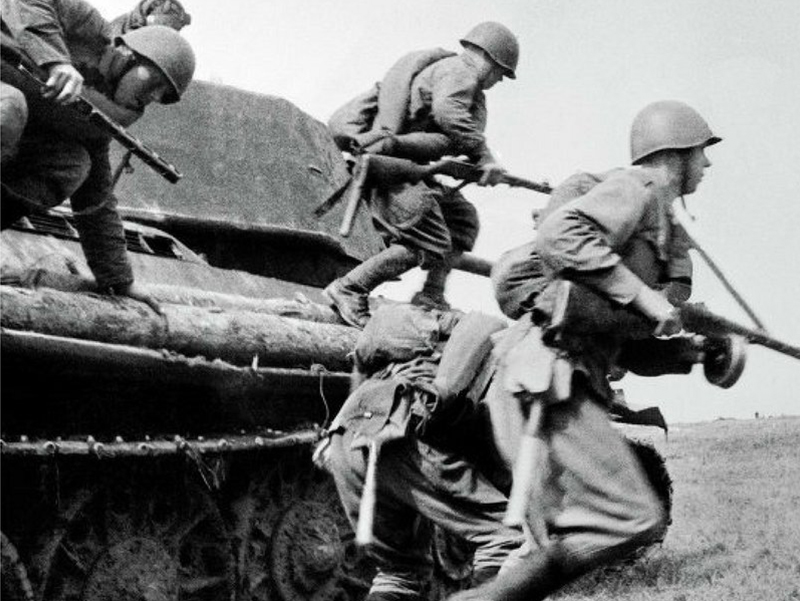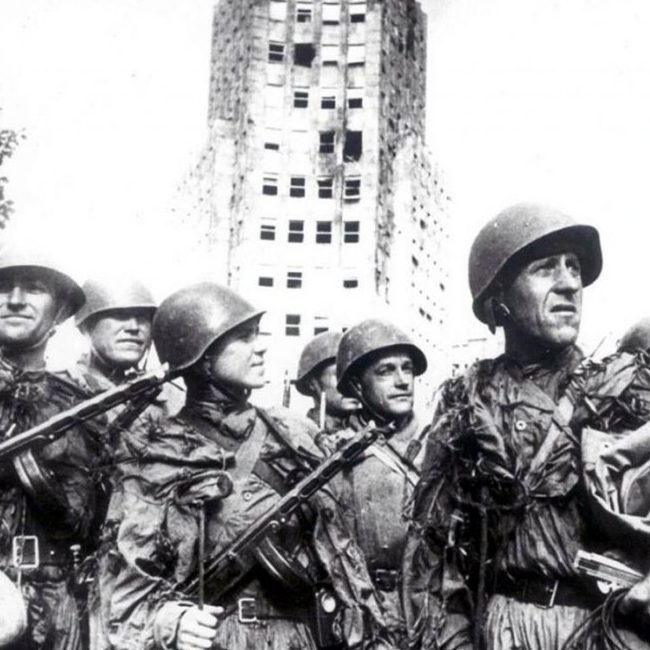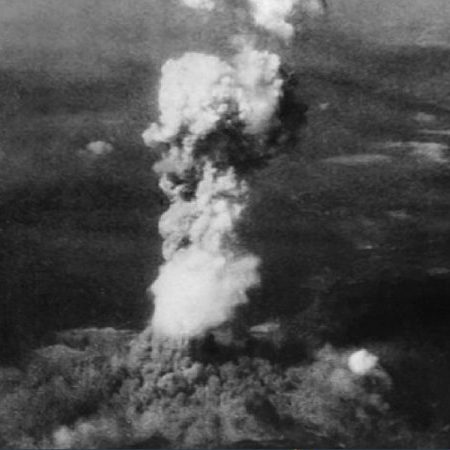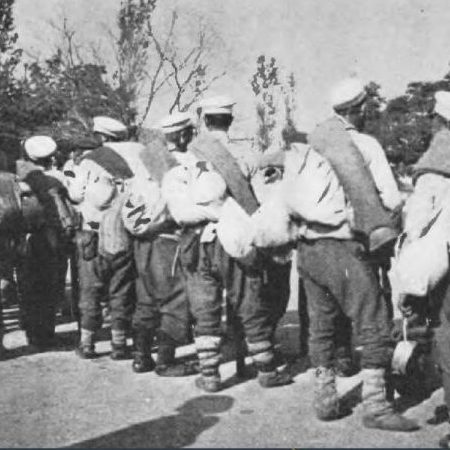
WAR CURIOSITIES: A fight to the death in the Reichstag
Berlin, last days of April 1945. The Third Reich is dying. As well as one of its most symbolic buildings: the Reichstag. Germany’s capital, surrounded by the Red Army, looks like a nightmare. Apocalyptic and infernal scenario of fire and destruction. Colossal smoke columns erupt where fire still consume what little remains to be burnt in Berlin.
Over the city, the leaden sky weeps thin layer of rain, too cold despite being spring… However, Berlin is a city where there is no respite from the weather. Nor does the Soviet artillery. For a few days now, the long-range pieces have punished the city centre to pleasure. It does not matter where you look; the hail of Russian shells has blown almost everything that remained standing. The once colourful Berlin’s government buildings are now piles of rubble. Facades flirting with gravity seem to follow with hollow glances the soldiers and civilians who dare to cross the sea of ruins that the German capital has become.
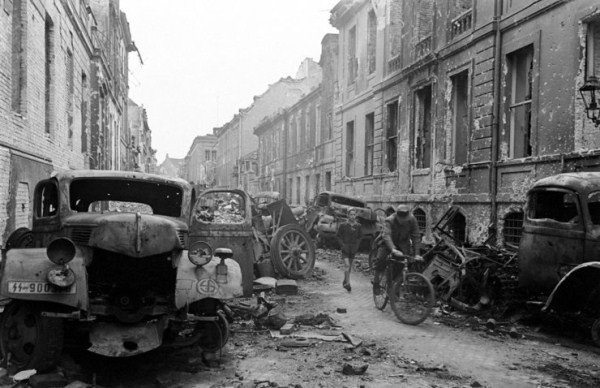
War-torn Berlin, ghost city
The prelude to the Berlin battle.
From the 25th, the Red Army’s infantry and armoured vehicles stalk the suburbs of Berlin. Few days ago, during the Battle of the Seelow Heights (16-18 April 1945) – the Russian’s penultimate great battle – the decimated German units have been forced to retreat to the Reich’s capital. Berlin, now called “fortress”, will be the scenario for the last battle between Soviets and Germans.
In Seelow, both sides have had terrible losses. Despite none of the contestants dare to give exact numbers, History – thanks to its infinite patience – estimates the casualties and wounded between thirty and fifty thousand… In just 72 hours of fighting.
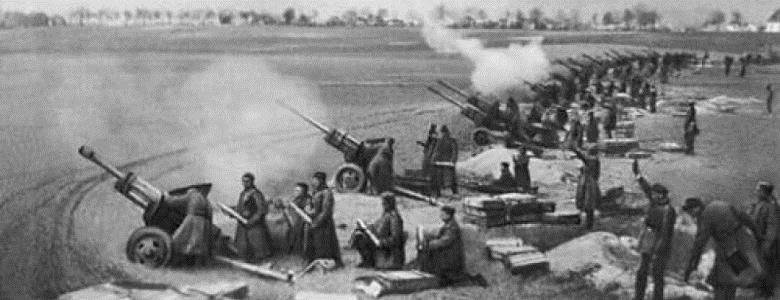
Soviet artillery at the Seelow Heights, East Berlin
At the end of April, the last Wehrmacht’s defensive line had to retreat to Berlin in order to, as a final effort, try to contain the Soviet attack. Many German soldiers have come back exhausted. They barely have food, water or ammunition. The foreign volunteers, who have accompanied them in their – more or less organized – retreat, do not fare any better. Amid the ruins or in gloomy cellars, conversations arise between Wehrmacht Germans and Waffen SS soldiers from Europe. Punished French, Belgian, Danish and Latvian units (even a handful of Spaniards) await the final offensive. Dry throats evoke better times. Water… A scarce resource to kill or die for.
Hitler Youth boys – some of them are just children playing at being soldiers – share the tense situation with senior veterans who look at them with compassion. They foresee their predictable end in silence. They know what war involves. With them, there are some men of respectable age; even those who have experienced the Great War at their core contemplate with wide-open eyes the results of the enemy’s artillery. When will the attack arrive? That question gnaws at all of them. Nerves on edge.
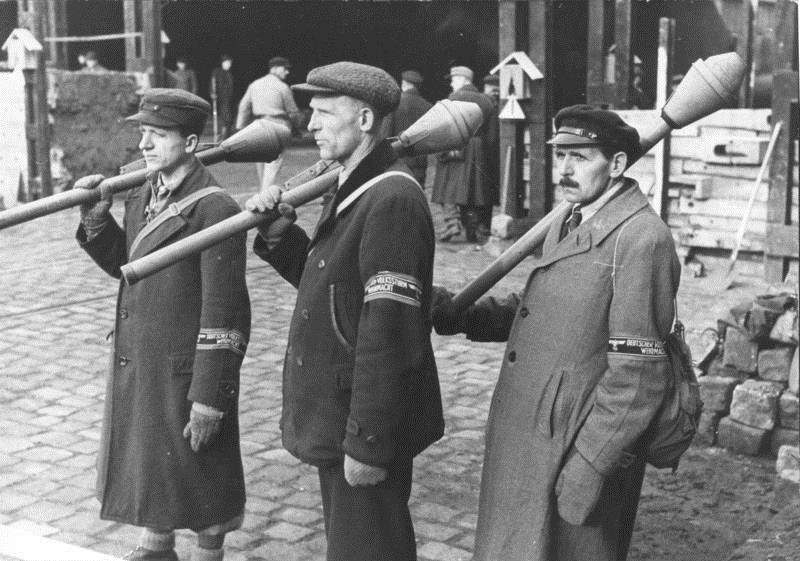
Last-minute recruited men, armed with Panzerfaust, fill the Volkssturm ranks
During the first hours and days of the Battle of Berlin, the Soviet tanks have launched exploratory attacks in the peripheral neighbourhoods. The furious resistance offered by barely 90,000 defenders (only half of them are soldiers) has been met with disbelief; the Red Army’s infantry has seen how dozens of their escorted armoured vehicles have succumbed under a devastating rain of fire. The Panzerfaust, anti-tank weapon used skilfully by the obstinate defenders, has revealed itself as a simple and effective solution to contain the enemy offensive in some city sectors. MG-42 machine guns, StG-44 assault rifles and hand grenades have not fallen behind as their power also serves to repel enemy attacks.
Some of those German soldiers, also several Waffen SS volunteers, carry a long-range weapon in the battle. It is a submachine gun called MP-40 (Maschinenpistole 40) of German manufacture, still a symbol of the Third Reich’s power – about to succumb in a matter of hours, maybe days. Its carriers, many of them experienced veterans, know perfectly how it is operated, not complex at all.
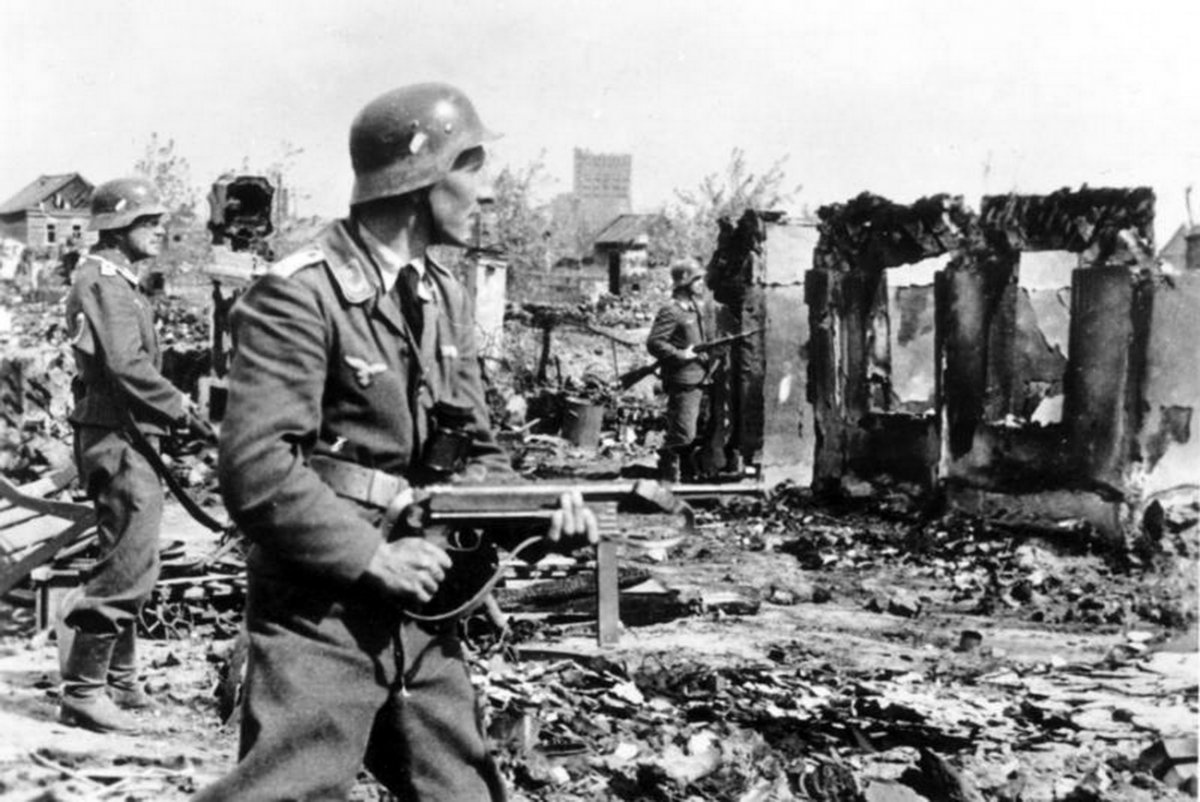
German soldier with a MP-40 in the, now distant, Battle of Stalingrad. Get your replica of this gun here
Brief background of the MP-40.
In 1938, Heinrich Vollmer designed a weapon that would go down in history. At the end of the First World War, German soldiers made use of MP-18 sub-machine guns to easily assault and clean the enemy’s trenches. However, it was not until the 1930s that this kind of weapons experienced a better development and a large-scale production.
The last worldwide battle had shown the futility of the attrition warfare, in favour of a manoeuvre warfare where all that mattered was to overcome, surround and destroy the enemy without hesitation. Moreover, the Great War and subsequent conflicts had remarked the importance of using weapons with a highest frequency of fire than the old bolt action; in favour of the automatic ones like the machine guns and the first sub-machine guns.
It was not long before nations started to develop and produce this kind of death instruments in a frenetic race to overcome their competitors. In the 1930s, Vollmer and other manufacturers dreamt of patenting the perfect weapon. However, in engineering, to reach a final design you have to go through different stages that imply effort and time. That was the case for the MP-40, a weapon that achieved its perfection in the middle of the Second World War. Several models came before, such as the MP-38, superior in material costs than the MP-40 and more difficult to mass-produce.
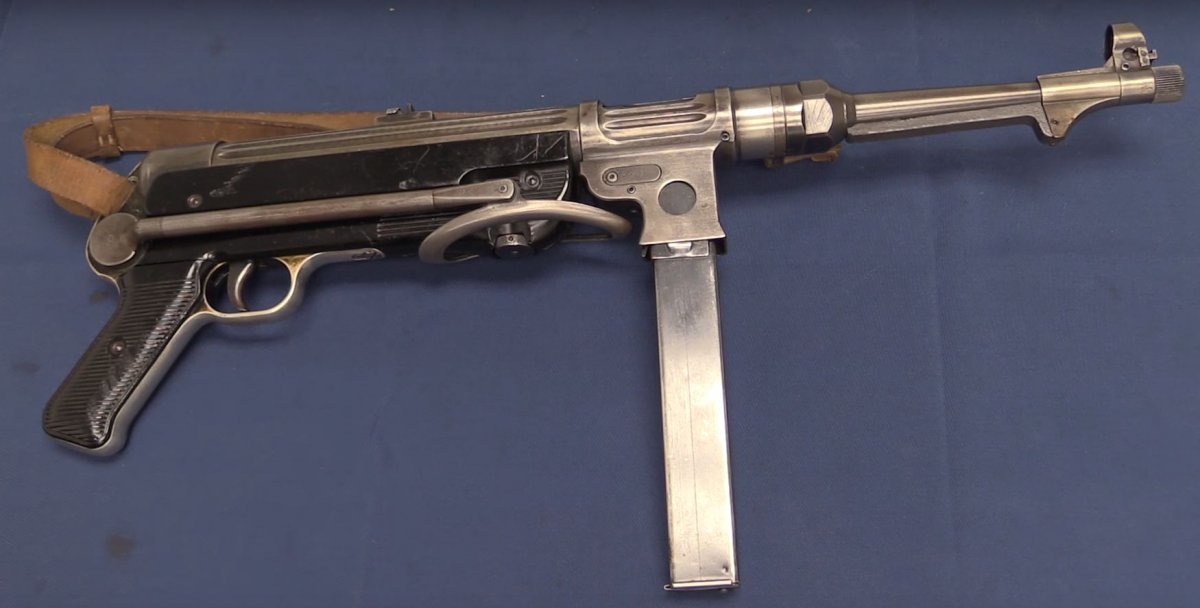
MP-38. Predecessor of the MP-40 submachine gun
A number of decisions led to the MP-40’s prevalence over the previous models; including the replacement of craft manufactured pieces, made using lathe and milling machines, in favour of prefabricated steel pieces, much easier to assemble and adjust – not to mention the reduction of the assembly lines operators’ working times.
With the war already ongoing, the MP-40 was identified as a fundamental weapon for the development of the Blitzkrieg (German lightning war), which requested this type of submachine gun for its infantry and armoured troops.
As a statistical note it is worth mentioning that, at the end of the Second World War, more than one million units were produced. Although the MP-40 broadly met the expectations and was reliable for those who used it, we must not overlook that it also had some disadvantages (compared to other similar weapons manufactured by some of the countries that participated in the fight). The American Thompson, the Russian legendary PPSh-41, the British Sten Mark II and even the Finnish Suomi KP/-31, presented their lights and shadows once they were put to the test on the battlefield.
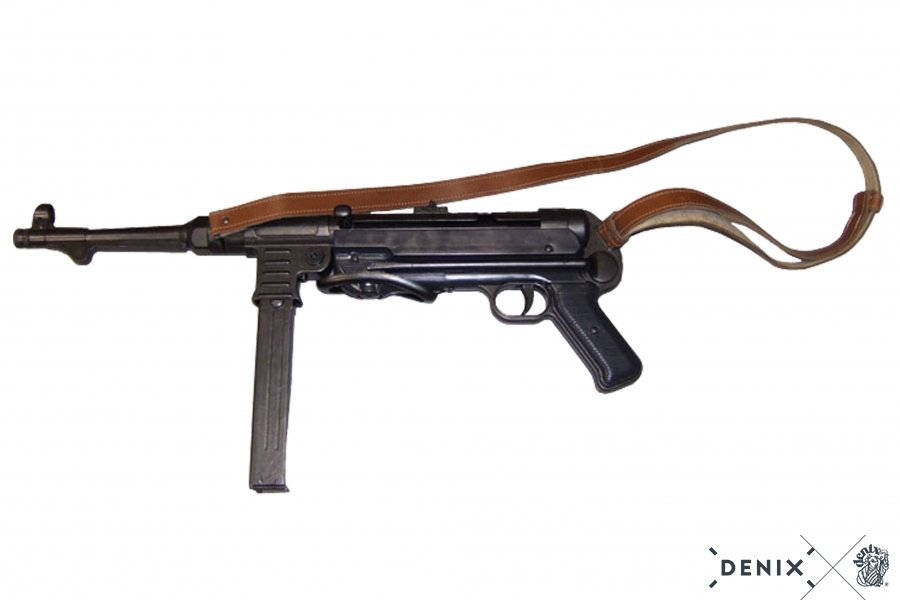
MP-40 replica by Denix. Get it here
The Third Reich comes to an end.
The morning of the 30 April 1945, Königsplatz, the spacious square lying at the feet of the Reichstag, could be compared to the lunar landscape. Mutilated by countless craters and a large anti-tank trench flooded with water that goes through almost its entire length from North to South, the square is about to host one of the most dramatic episodes in the Battle of Berlin.
In the previous day, the Soviet infantry, supported closely by numerous tanks, has managed to take control of several buildings in the symbolic enclosure. Königsplatz, located right in the middle of the diplomatic district of Berlin, is hardly recognizable. Every building that surrounds it, with no exception, has been destroyed by artillery and bombing. The Red Army is not willing to lose more tanks and men than what is strictly necessary. The takeover of the nearby Moltke Bridge and the Ministry of the Interior, inside which the shots of the last German defenders still thunder, has resulted in a haemorrhaging of casualties for the Soviet High Command. It is time to strike the final blow…
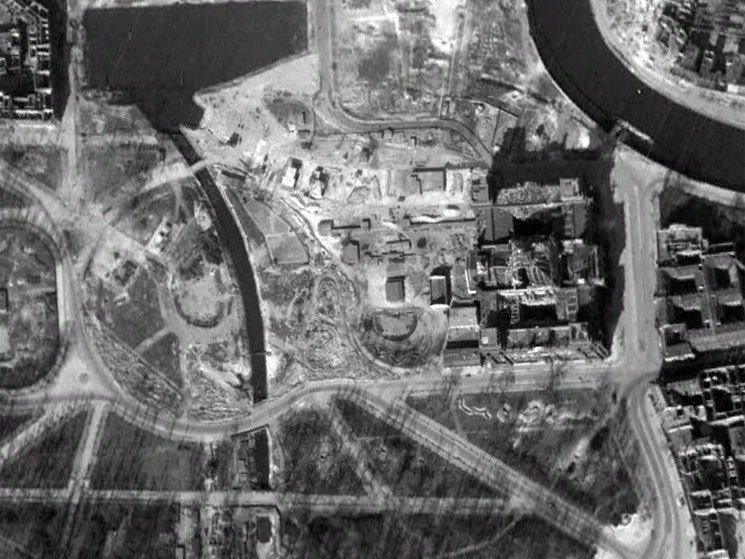
Aerial view of Königsplatz, the Reichstag on the right
Crouched inside the craters that populate Königsplatz, the German soldiers await the Soviet assault. At the first light of day, accompanied by a relentless rain from the greyish sky, nervous hands feel the weapons that they will have to use to face the Russian bulldozer. The MP-40s, worn out by the passage of time, seem to have lost the brightness of their first days of life.
The brave soldiers look at the patina that decorates the weapon’s metallic surface, as if it was a deserved decoration after having endured the passage of time in the front, together with their masters, faithful until the end.
While some check that the trigger mechanism works correctly, others are ready to load the ammunition. Each one has capacity for thirty-two cartridges, a lifesaver at the crucial moment. The most veteran know that, to avoid problems with the weapon, it is more convenient to insert thirty, because some colleagues, betrayed by the capricious weapon’s loading system, are no longer among them.
Around five thousand men allocated in the Reichstag’s sector listen to the terrifying symphony that emerges from the other side of the river Spree. Crossing the large river, the Moltke Bridge, scene of dramatic combats hours ago, stands as a vital walkway for the Russian armoured companies. The roar of their engines reaches the German defenders’ ears. Soon, the silhouettes of the Soviet T-34s are spotted on the street that leads to Königsplatz. Between the smoke and the dust that flood the capital, the piles of steel are moving forward slowly, cautious, as the crews have learned that rushing in the streets of Berlin means dying sooner.
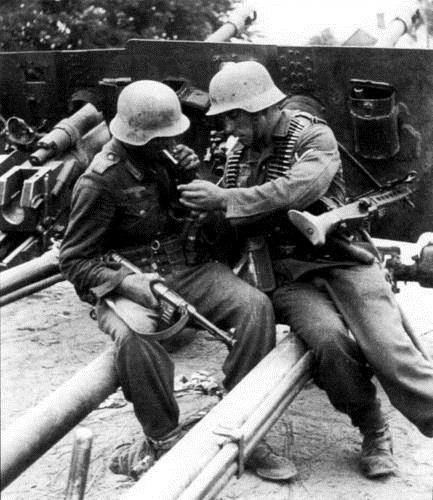
Two soldiers share tobacco before the imminent battle (left a MP-40)
Suddenly, several death trails appear in the air. They are the German Panzerfaust, flying to meet the enemy tanks. It does not take long to hear a barrage of explosions. One German at the forefront has hit the target completely. The flames consume those tanks reached by the shaped charge projectiles, capable of destroying the steel beasts as if they were tin toys. The initial cheers intermingle with the wailing of the wounded: as they retreat towards the Reichstag, the reckless German tank-hunters fall under the implacable Russian fire.
More and more tanks make their way to the Reichstag despite the intense German fire. Nourished infantry groups escort those gigantic monsters that roar their powerful cannons unceasingly. The floor rumbles. It seems it will break apart. The T-34s and the powerful KV-1s burst violently at Königsplatz, just a step away from victory.

Moltke Bridge
Final moments in the Reichstag.
It’s time for the hand-to-hand combat. With the Soviet infantry already in the square, the Germans emerge from their craters or, staying behind the bulwark, stick out their weapons pointing towards the brown tide. Hundreds of Russian soldiers fire their weapons at the mass, because they know their superiority in number to the exhausted defenders. Above their heads, dozens of shells fired from the artillery and the tanks; a blast of steel and destruction to protect their colleagues.
The infantry of the Wehrmacht and the Waffen SS fire their weapons to try to repel the enemy’s attacks. Many MP-40 sing along their death hymn. Those who have the skills empty one cartridge after another. With the finger stuck to the trigger, thirty cartridges last inside less than five seconds. Shortly, they will hear the usual requests. Wounded and shooters, unharmed by miracle, claim assistance and ammunition respectively. The Soviet power takes the first lines of trenches, but not without paying a high price in human lives; not to mention the losses of tanks, terrifying.
Under the Reichstag’s facade, the desperate defenders, with their fingers attached to the MP-40’s triggers, were firing everywhere. In front of them, the Red Army soldiers are collapsing as if they were bowling pins. Behind the walls of the government building, more Germans fire their Kar-98s and modern StG-44s in a suicide attempt to contain the position.
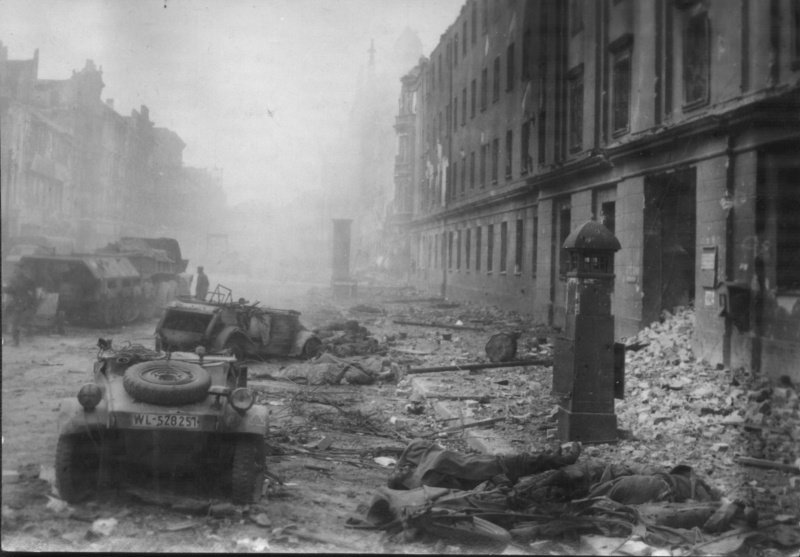
In other areas of the city, the aftermath of the fighting is devastating
Under his feet, the basements of the Reichstag stink of death. Crowded with wounded, with little light to practice first aid to those who arrive crushed from the battlefield, and even less to carry out a surgical intervention. The entrails of the gigantic building mutilated by the artillery have become an authentic carnage. Not even the gloom reigning down there can hide the heart-breaking scene seen by dozens of men, some willing to fight until the end, others about to lose their minds.
As the hours go by, the battle intensifies to unsuspected heights. They request to the antiaircraft tower of the zoo to sweep the entire length of Königsplatz with its powerful cannons. And it happens. The moment has arrived: the deafening whistle of the large-calibre shells approaching from the western end of the nearby Tiergarten Park. Soil geysers, able to hide a building, sprout from the ground with murderous rage. The Soviet infantry flies through the air as if they were rag dolls. Also the Russian tanks, weighing several tons, are thrown into the sky to fall again, converted into sparkling scrap metal and human remains.
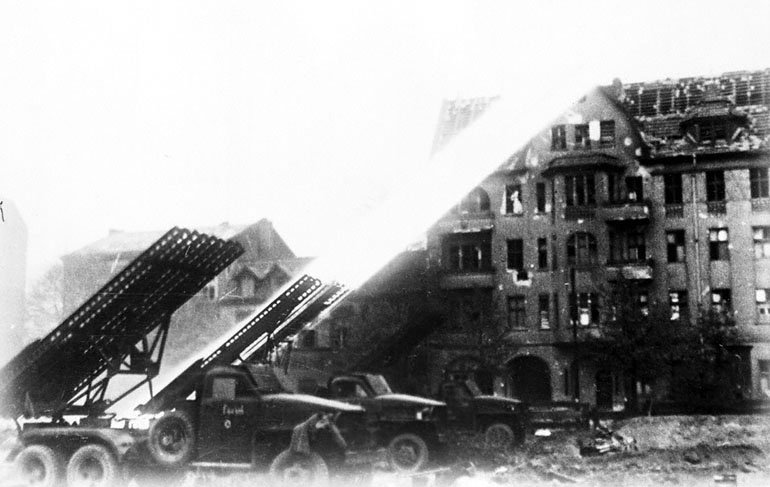
The Soviet “Stalin’s organs” destroy the entire city
At dusk, the Red Army’s forward lines managed to break into the Reichstag. Outside, the absolute devastation. Hundreds of corpses, scattered everywhere, lie next to each other in grotesque positions. Their weapons, inseparable companions until the owner’s last breath, still expel smoke through the cannons. They have worked tirelessly from very early in the morning. The lifeless bodies of Russians and Germans, enemies until a moment ago, now take the path to eternity together. Several PPSh-41 and MP-40, abandoned on Königsplatz’ muddy soil are recovered by the Red Army soldiers who shortly will receive the order to assault the Reichstag. Behind its walls, it is more appropriate to handle the enemy armed with a submachine gun than with a simple bolt-action Mosin–Nagant.
May 1, decisive day in the Berlin Battle.
Early hours of the first day of May and there is no respite from the fight. Inside the Reichstag, fights take place in the corridors, staircases and basements. All-out war. Room by room. The hand-to-hand combat is inevitable. Those who defend the government building know they have their backs against the wall, because they do not expect mercy from the Russians. There is no other option but to hold out until the end. Fanaticism has nothing to do with ideologies by now, it all comes down to trying to save one’s own life; and the one from the wounded or dying friend bleeding side by side with someone who still stands, to shoot at point blank against every Soviet soldier who steps in.
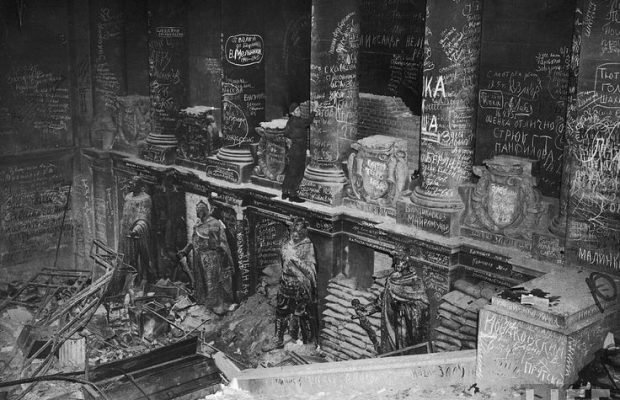
Interior of the Reichstag; the destruction of what remained after the battle
Each room has been transformed into a fort. Authentic fortresses defended by men desperate to survive one more day. The Red Army pays a high price for attempting to place the Russian flag on top of the Reichstag. Any room taken by force translates into a bloodbath for Stalin’s troops.
Despite this, the Soviet commanders throw more and more men to the meat grinder that the phantasmagorical and gloomy building has become. A place destroyed by the shells where the only source of light comes from candles, lamps and the intermittent flashes and explosions of hand grenades. Electricity is an inaccessible luxury that has vanished.
Throughout the whole day, despite the efforts of the Red Army to bend its eternal enemy once and for all, wild brawls take place behind the damaged Reichstag walls. The Wehrmacht and the Waffen SS units destined there resist and fight back. The MP-40 of one and all shoot frenetically without stopping. Cornered, the defenders retreat towards the depths of the basement in a desperate attempt to contain the Russian offensive. Down there, wounded and nurses struggle in a primitive, merciless fight.
The soundtrack of the day is made of the clattering of sub-machine guns and hand grenades. Hundreds of nine-millimetre shells stretch like a carpet under the feet of the last guardians of the Third Reich´s political symbol. Countless MP-40s still burst through the darkness. The StG-44 assault rifles and the German Lugers join the deafening symphony.
On the other hand, the Russian infantry, with their PPSh-41s at the ready, wipe out rooms almost blindly due to the thick smoke that floods every corner of the basement. The intense smell of death, explosives and burned gunpowder permeate the lungs of those still alive to continue fighting.
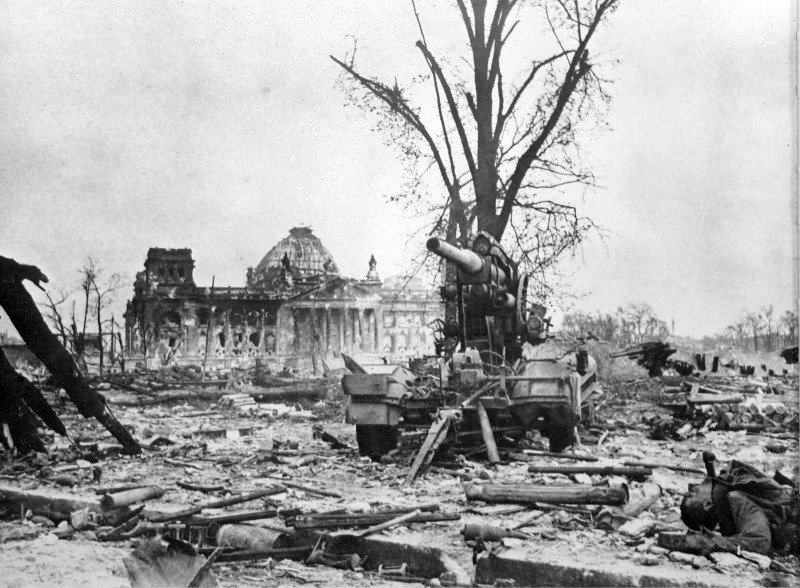
Exterior view of the Reichstag. In the foreground, a German 8.8 cm used as desperate anti-tank defence
Late in the day, the fight seems to come to an end… Or that is what some Russian soldiers believe, over-confident after seeing the surrender of several German groups, rather than dying in that nightmarish scenario. Soon they will wake up from that unreal dream.
Several Red Army commanders, hours ago, also dreamed of hoisting the Russian flag on top of the Reichstag to offer the capitulation of Berlin as a gift to Stalin on the symbolic May 1.
Only a small group of soldiers, almost at the end of April 30, was able to wave something similar to a red flag on the roof. However it didn´t last long; they had to back down as the fight swept the building from top to bottom.
The end.
Finally, after the sunrise on May 2 a German officer, General Weidling, signed the capitulation. Only a few minutes away from nine o’clock. An hour displayed on the watches such as the Russian soldier´s one captured by the camera of Yevgueni Jaldéi.
An original snapshot that, after being modified to give it greater drama and to remove possible interpretations of the sacking committed by the Soviets, remains engraved in our minds.
First hours of May 2, the last shots resounded inside the Reichstag as the sun rose to the highest point of the sky. German soldiers, unaware of the surrender signed by Weidling, still refused to capitulate. As in other places of the ghost town, small groups refused to accept the end of the hostilities. Nestled among ruins, hungry, without water and with the last cartridges loaded, they were soon brushed aside.
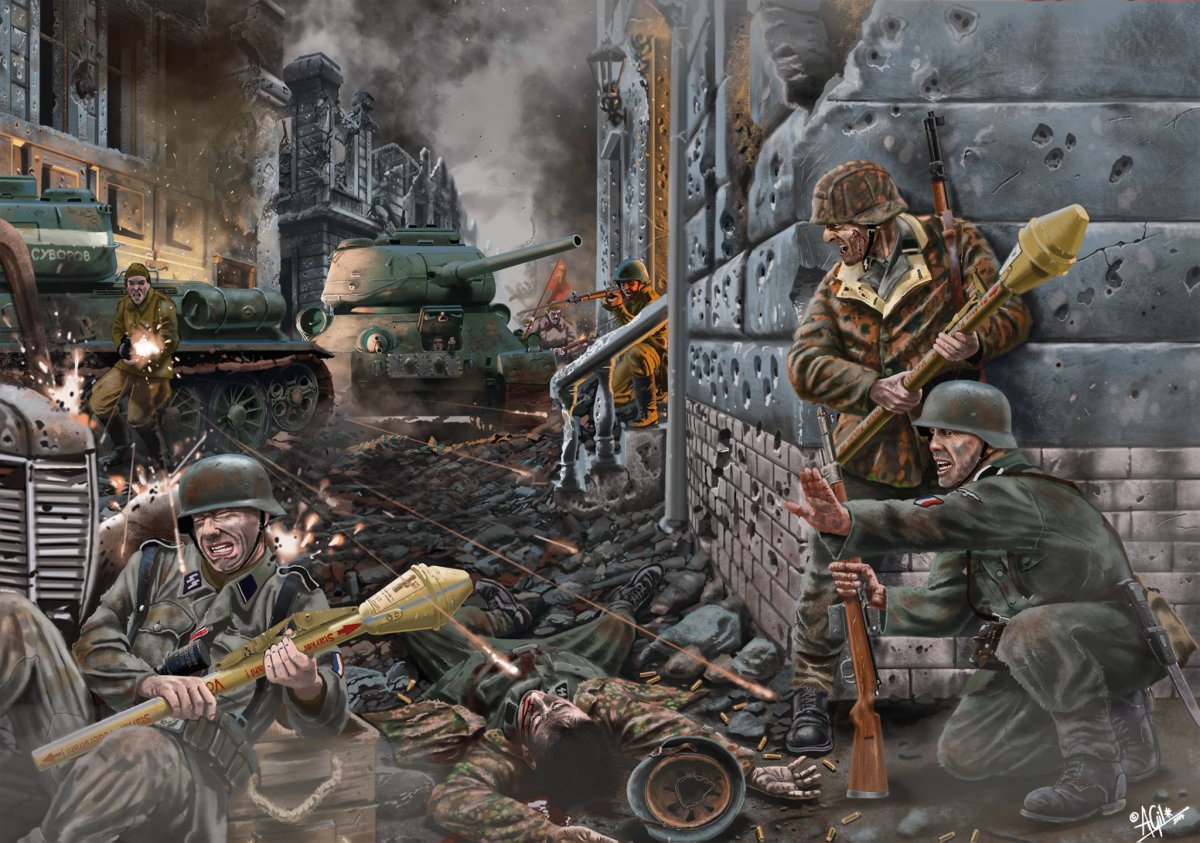
Realistic illustration by Antonio Gil that shows a handful of French Waffen SS, among the last defenders of Berlin, in fierce struggle with the Red Army
The Soviet soldiers in charge of reducing the pockets of resistance in the Reichstag´s basement discovered, when returning the calm after furious hours of combats, that their enemies lay on a mantle of rubble, adorned with shells that reflected the dim lantern´s light.
Like so many others, a Russian soldier leaned back on the corpse of a German officer whose uniform, bloody and dusty, proudly displayed several decorations. That man, lifeless, still clinging to his weapon, seemed unwilling to release the piece of lethal engineering that accompanied him on his deathbed.
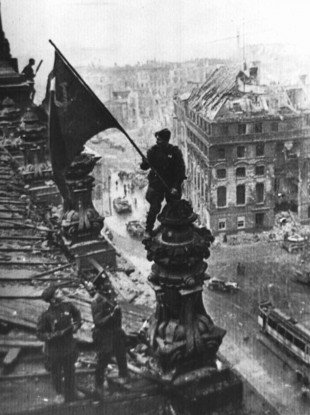
Soviet soldiers on the Reichstag´s roof raise the USSR flag
A weapon that, together with its owner, had seen better times, when had fought in France on board a half-track. A weapon that had shared other scenarios, such as North Africa and Italy. But a weapon that, inevitably, had the privilege to witness the last hours Adolf Hitler´s regime in the capital of the Third Reich itself.
That Russian soldier, young and curious, whose attention was on the officer pierced by bullets, did not want to miss the opportunity to return to the Motherland with a valuable, symbolic, legendary memory from that moment… It was an MP-40 whose surface, with a characteristic patina caused by the passage of time, reflected the beam of light projected by the lantern of that soldier arrived from the Urals.
Holding it tightly, he raised the MP-40 in the air and, repressing a victorious cry in his throat, waved and showed it to his platoon comrades.
The war was over.
If you liked it, share it!
The Mk II/Mk 2 series fragmentation grenade was the standard American Army infantry hand grenade from 1918 until the 1960s. Perhaps better known as the “pineapple” grenade for its patterned grooved metal body, the Mk II served in the latter months of World War 1 and throughout World War 2, the Korean War, the Vietnam War and various other period conflicts during its operational tenure. Other operators went on to include the armed forces of Argentina, Chile, Israel, Italy, the Netherlands and Turkey.
The Mk II first appeared in 1918 and saw limited use in the Great War replacing the Mk I series hand grenade of 1917. The original Mk I was a product of American design and introduced in 1917. However, there were noted ignition issues with the mark forcing production to be halted and delivered grenades to be recalled en masse. Eventually, the Mk I series was dropped from service in 1918, replaced by the much improved Mk II series – leaving the Mk I as a footnote in American military history.
Outwardly, the Mk II grenade was of a traditionally accepted hand grenade design encompassing a fragmentation body attached to a percussion-cap-and-time-fuse-delay detonation system atop a tapered neck. A ring held a safety pin in place prior to the grenade’s activation. The time fuse delay ran for approximately five seconds after activation to which the operator would lob the device against an enemy. The body of the grenade was manufactured of iron and dotted by a pattern of protruding blocks which gave the grenade its unique appearance while also aiding in its handling. The internal contents of the grenade consisted of 2 ounces of TNT filling to which, once detonated, would shatter the iron body in every direction, causing massive fragmentation damage to everything and anything within the blast radius. Initial production forms utilized an igniting fuse system while later models gave way to a detonating fuse arrangement.
The initial production model became the Mk II of 1918 which was followed by the revised Mk IIA1 of 1942. By this time, America was fully committed to the war effort that was World War 2 and production of all war goods spiked substantially. The Mk IIA1 variant was differentiated by its lack of a bottom “filler” hole and used the M10A2 igniting fuse (as opposed to the M10A1 and M11 series seen prior). A “high-explosive” version – the Mk II HE – was then issued with an M5 detonating fuse while the Mk II FRAG-TNT was completed with the M6A4C detonating fuse. During the war 2, the grenade could also be equipped with stabilizer fins and a tube body for firing from the muzzle of service rifles equipped with the M7 adapter, this configuration giving the standard infantryman a broader tactical reach against dug-in foes. The Mk II/ Mk 2 series served on until its circulation reach was minimized, ultimately replaced by more modern and efficient hand grenade types the world over. In April of 1945, the Mk II series (note Roman numerals) was redesignated as the “Mk 2”. The variants naturally followed suit in the US Army inventory, each dropping their Roman numeral identifiers.
The Mk II series was eventually replaced in the American inventory by the smooth-sided (and decidedly egg-shaped) M26 series of the 1950s.
View our collection of mp40 and variants here
An article by Denix guest blogger: Daniel Ortega del Pozo.
An article by Denix guest blogger: Daniel Ortega del Pozooriginal post published on DENIX website on 12/07/2018


